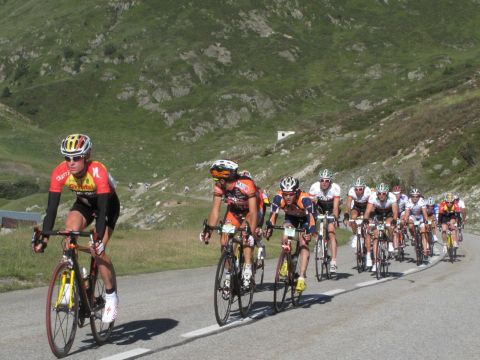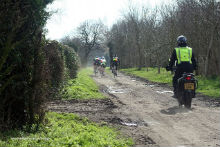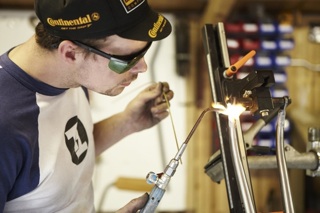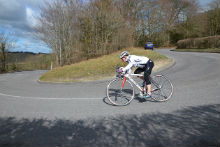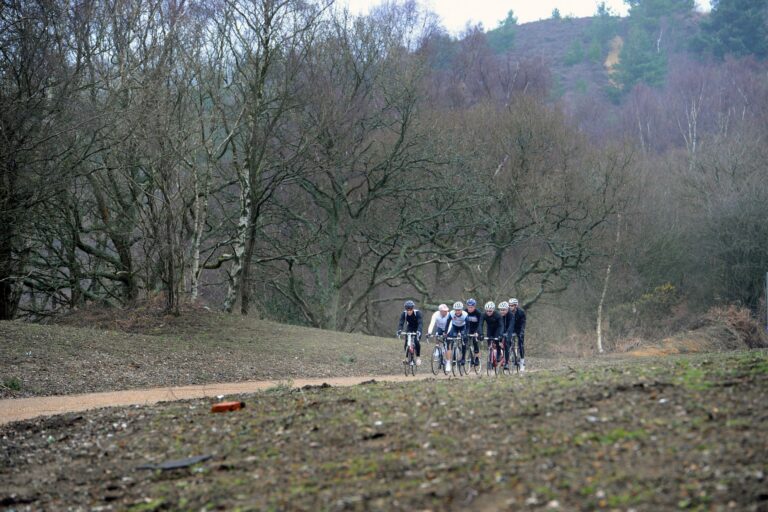
- Pic: tignon.be
In part 1 we looked at the different types of European events that we in the UK often lump together as ‘sportives’. Our focus in this and future articles will be on ‘sportive’ racing as it is understood on the Continent.
The first thing you’ll notice is that most are run on closed roads. The very large events may have roads closed for the whole circuit, while smaller sportives will have rolling road closure enforced by marshals, motorbike outriders and lead cars. (The level of road closure diminishes the further down the field you ride). This not only creates a notably safe environment, but gives a sense of occasion you’ll rarely feel on the UK’s home roads.
The start is usually neutralised for the first couple of kilometres, although speeds frequently hit 50km in this section as people scramble to get to the front. As soon as the lead car pulls in the flag the racing starts and there are often attacks from the word go. It’s this stage that’s usually the most dangerous with many riders not being used to riding in a huge bunch and the inevitable crashes often ensue. This is no different from any other road race and if you want to place well you need to get to the front and stay there out of harm’s way.
If you get a chance to look around at this stage, you’ll see lead cars and motorbikes, neutral service and team cars, crowds of spectators, plus the dreaded broom wagon at the back. There are often film crews for local and national TV and the largest events even use helicopters! You’ll be forgiven for thinking you’ve just started a stage of the Tour.
Prestigious look and feel
This gives the look and feel of a prestigious road race, but there are big differences. The most obvious being that sportives are often defined as ‘open’ or ‘public races’ in the same way as you’d run a marathon, with everyone starting together regardless of category. The top riders generally start at the front (but not always), then the club riders race amongst themselves or simply try to get around and achieve a gold, silver or bronze award.
Events are generally staged on one large (often iconic) circuit as opposed to the many smaller laps usually used in a road race. If you get dropped in a sportive you’ll soon be picked up by a chasing bunch and can carry on your race. In a road race, when you’ve been dropped by the bunch it’s usually game over and that’s your race finished. As soon as you can picture them as ‘open races’ with feed stations (for those who want them) and mobile support you’ll get more from the event.
Cyclosportives differ widely in scale from the very small to the ‘monuments’, the most well known being L’Etape du Tour, which is a goal for thousands each year. These ‘monument’ events feel very different to smaller sportives and for some are less personal. Due to the extreme numbers, the start is usually in a grid system with ‘elite’ or high ranking riders in the front bunches. The following grids often mix riders of all abilities, from the very experienced to the complete novice whose focus is simply to finish an iconic stage of le Tour.
The standard of riding obviously suffers as a result and this can not only be very frustrating for many in terms of getting through an enormous bunch to get a good finish time and position, but also extremely dangerous without the correct skills to ride in a bunch, hold a line in a corner or descend. For many this will paint the wrong picture, putting them off the idea of competitive sportives for life, while for others it will inspire them to do more. A top place in a monument event such as the Etape or La Marmotte will often lead to greater things and for younger riders this can mean gaining a place in a top pro team – many top riders have been spotted in this way. For older riders (often ex-pros) a good result not only brings prestige, but also substantial rewards.
Monument events
Many view the monument events such as La Marmotte as the ultimate challenge and the hardened few have started to ride these events back to back. This has lead to the rise of the ‘ultra sportive’, the toughest of which is the Tour du Mont Blanc. Quoted as 330km with 8,000m+ of climbing, it’s actually 335km with 8,651m and takes in France, Switzerland and Italy in the one day tour of Europe’s highest peak. This attracts a global field of many full time riders and endurance specialists and is the equivalent of two monument events in one. More on this event in later articles….
So why race? The prizes can be substantial and many people make a comfortable living from ‘sportive’ racing. There is a huge number of National and Regional Trophies and each event placing gives a ranking for the series. This is very important not just for individuals, but for teams too. This has led to the growing number of dedicated sportive teams, many of which include paid full- and part-time riders with all costs and equipment covered. The budgets can be substantial (well into six figures) and this is not only lifting the standard of riding to a new level, but leading to very tactical team-dominated events. There is even a cyclosportive world championship!
Any event today will have not only full-time sportive riders, but also pros and some now even have separate prizes for pros and amateurs. Shows the way these races are regarded!
The best websites to find the events are:
France – velo101.com
Belgium – wielertourist.be
Italy – dalzero.it
Germany – cycling-cup.de
We also list a selection on our own website
In the next article, we’ll look at how to plan your European sportive and what you’ll need
About the author:
Andrew Thompson started racing in 1983 and has competed in road and off-road events, both in the UK and in Europe. He is a director of Cicli di Tomsoni Ltd, the UK importers of A:xus bikes from Germany and Thompson Bikes from Belgium.

